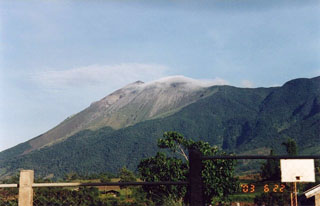Report on Kanlaon (Philippines) — 11 December-17 December 2024
Smithsonian Institution / US Geological Survey
Weekly Volcanic Activity Report, 11 December-17 December 2024
Managing Editor: Sally Sennert.
Please cite this report as:
Global Volcanism Program, 2024. Report on Kanlaon (Philippines) (Sennert, S, ed.). Weekly Volcanic Activity Report, 11 December-17 December 2024. Smithsonian Institution and US Geological Survey.
Kanlaon
Philippines
10.4096°N, 123.13°E; summit elev. 2422 m
All times are local (unless otherwise noted)
The Philippine Institute of Volcanology and Seismology (PHIVOLCS) reported continuing eruptive activity at Kanlaon during 11-17 December. The seismic network recorded 2-32 daily volcanic earthquakes, and sulfur dioxide emissions ranged from 3,620 to 8,600 tonnes per day. Gas-and-steam emissions that were continuous rose 50-100 m above the summit and drifted mainly W, WSW, SSW, and SW; weather clouds obscured views on 11 and 13 December. There were 1-6 ash emission events during 3-5 and 7-8 December, with each lasting 3-40 minutes. Periodic ash emissions were recorded during the week: two ash emission events lasting 11-29 minutes occurred on 10 December, 13 ash emission events on 12 December were as short as two minutes and as long as 78 minutes, and four ash emission events on 16 December lasted 6-35 minutes.
The Disaster Response Operations Monitoring and Information Center (DROMIC) report issued at 2000 on 17 December stated that 15,391 people (4,865 families) were spread across 32 evacuation centers and another 2,711 people (803 families) were staying elsewhere. The report also stated that 40 people involved with farming or fishing were affected, a total of 21.27 hectares of agricultural fields were damaged, and 32 cities had declared a “state of calamity”. The Alert Level remained at 3 (on a scale of 0-5); the public was warned to stay 6 km away from the summit and pilots were warned not to fly close to the volcano.
Geological Summary. Kanlaon volcano (also spelled Canlaon) forms the highest point on the Philippine island of Negros. The massive andesitic stratovolcano is covered with fissure-controlled pyroclastic cones and craters, many of which are filled by lakes. The largest debris avalanche known in the Philippines traveled 33 km SW from Kanlaon. The summit contains a 2-km-wide, elongated northern caldera with a crater lake and a smaller but higher active vent, Lugud crater, to the south. Eruptions recorded since 1866 have typically consisted of phreatic explosions of small-to-moderate size that produce minor local ashfall.
Sources: Philippine Institute of Volcanology and Seismology (PHIVOLCS), Disaster Response Operations Monitoring and Information Center (DROMIC)

